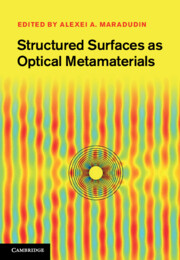Book contents
- Frontmatter
- Contents
- List of contributors
- Preface
- 1 Physics of extraordinary transmission through subwavelength hole arrays
- 2 Resonant optical properties of nanoporous metal surfaces
- 3 Optical wave interaction with two-dimensional arrays of plasmonic nanoparticles
- 4 Chirality and anisotropy of planar metamaterials
- 5 Novel optical devices using negative refraction of light by periodically corrugated surfaces
- 6 Transformation of optical fields by structured surfaces
- 7 Surface electromagnetic waves on structured perfectly conducting surfaces
- 8 Negative refraction using plasmonic structures that are atomically flat
- 9 Anomalous transmission in waveguides with correlated disorder in surface profiles
- 10 Cloaking
- 11 Linear and nonlinear phenomena with resonating surface polariton waves and their applications
- Index
- Plate section
- References
1 - Physics of extraordinary transmission through subwavelength hole arrays
Published online by Cambridge University Press: 01 June 2011
- Frontmatter
- Contents
- List of contributors
- Preface
- 1 Physics of extraordinary transmission through subwavelength hole arrays
- 2 Resonant optical properties of nanoporous metal surfaces
- 3 Optical wave interaction with two-dimensional arrays of plasmonic nanoparticles
- 4 Chirality and anisotropy of planar metamaterials
- 5 Novel optical devices using negative refraction of light by periodically corrugated surfaces
- 6 Transformation of optical fields by structured surfaces
- 7 Surface electromagnetic waves on structured perfectly conducting surfaces
- 8 Negative refraction using plasmonic structures that are atomically flat
- 9 Anomalous transmission in waveguides with correlated disorder in surface profiles
- 10 Cloaking
- 11 Linear and nonlinear phenomena with resonating surface polariton waves and their applications
- Index
- Plate section
- References
Summary
A brief reminder of the history of grating anomalies and plasmon surface waves
The recent history of the research and development around plasmon surface waves that was initiated by the work published in Nature in 1998 by Ebbesen et al. [1] looks like a ten-fold compressed version of studies initiated more than a century ago by Robert Wood with his discovery of anomalies in the efficiency of metallic diffraction gratings, now known as Wood's anomalies [2]. In 1902, R. Wood wrote: “I was astounded to find that under certain conditions, the drop from maximum illumination to minimum, a drop certainly from 10 to 1, occurred within a range of wavelengths not greater than the distance between the sodium lines,” an observation that marked the discovery of grating anomalies.
The first period of the search for their explanation is marked by the attempt of Lord Rayleigh [3, 4] to link Wood's anomalies to the redistribution of the energy due to the passing-off (cut-off) of higher diffraction orders of the grating (transfer from propagating into evanescent type). As pointed out by Maystre [5], his prediction was all the more remarkable as the author first ignored the groove frequency of the grating used by Wood, and thus could not verify this assumption with experimental data.
- Type
- Chapter
- Information
- Structured Surfaces as Optical Metamaterials , pp. 1 - 27Publisher: Cambridge University PressPrint publication year: 2011
References
- 3
- Cited by



